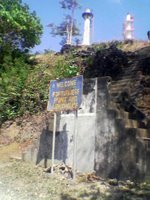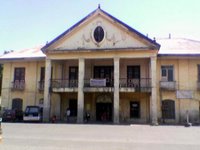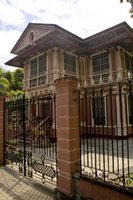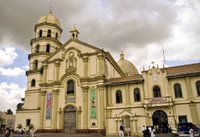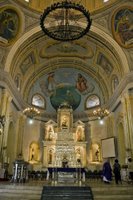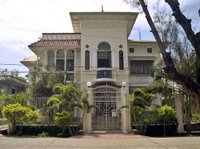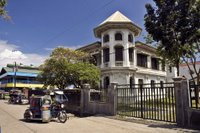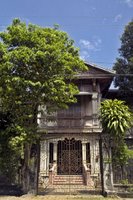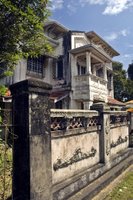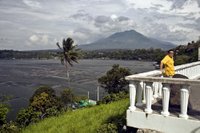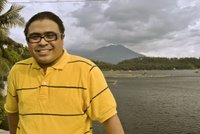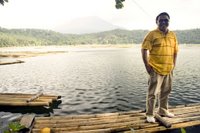 What a day! I'm about to leave the Bolinao Marine Lab of the UP MSI for my trip back to Pampanga. It seems my laptop crashed so I'm using Sasa's for the meantime. Just my luck! Anyway, I helped Sasa in the field this morning. At the moment, he is a research assistant for a sea cucumber breeding projet of the DA-Bureau of Agricultural Research. They are developing culture of a certain species of sea cucumber - Holothuria scabra, not only for commercial purposes but for re-seeding depleted stocks as well.
What a day! I'm about to leave the Bolinao Marine Lab of the UP MSI for my trip back to Pampanga. It seems my laptop crashed so I'm using Sasa's for the meantime. Just my luck! Anyway, I helped Sasa in the field this morning. At the moment, he is a research assistant for a sea cucumber breeding projet of the DA-Bureau of Agricultural Research. They are developing culture of a certain species of sea cucumber - Holothuria scabra, not only for commercial purposes but for re-seeding depleted stocks as well. One thing the Philippines fails to realize is its potential competitive advantage in aquaculture. The said sea cucumbers we were working on are among the most expensive, if not the most expensive in the market. The photo on the right are young H. scabra sea cucumbers that were bred at the lab which we were going to plant in the research pens near Santiago Island. If only the goverment spent more on research and development, not just in aquaculture, but in various fields since we have so much raw talent and natural resources available here in the country.
One thing the Philippines fails to realize is its potential competitive advantage in aquaculture. The said sea cucumbers we were working on are among the most expensive, if not the most expensive in the market. The photo on the right are young H. scabra sea cucumbers that were bred at the lab which we were going to plant in the research pens near Santiago Island. If only the goverment spent more on research and development, not just in aquaculture, but in various fields since we have so much raw talent and natural resources available here in the country.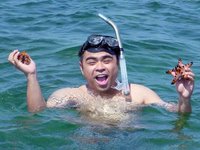 We took a pump boat from the lab to waters near Santiago Island where research is ongoing on various projects. Another project which they are working on is the breeding of sea urchins for re-seeding as well. Stocks have been depleted (see comment below) since fishermen overcollected them in the 80s and the 90s for the Japanese uni market. While Sasa and his assistants were putting the young sea cucumbers in their pens, I went snorkelling amongst the sea grass to check out the wildlife and saw quite a number. In my hand are a sea urchin - Tripneustes gratilla, and a starfish - Protoreaster nodosus. The urchin in my hand is the one they breed for uni.
We took a pump boat from the lab to waters near Santiago Island where research is ongoing on various projects. Another project which they are working on is the breeding of sea urchins for re-seeding as well. Stocks have been depleted (see comment below) since fishermen overcollected them in the 80s and the 90s for the Japanese uni market. While Sasa and his assistants were putting the young sea cucumbers in their pens, I went snorkelling amongst the sea grass to check out the wildlife and saw quite a number. In my hand are a sea urchin - Tripneustes gratilla, and a starfish - Protoreaster nodosus. The urchin in my hand is the one they breed for uni. After that, we went to check out the pens of the older sea cucumbers to dig out for them. These were brought back to the lab for monitoring and weighing, then thrown back into the pens. Yikes! I didn't realize digging for sea cucumbers would be hard since they burrow themselves under the sand. It took us quite a while to find them. Hehe!
After that, we went to check out the pens of the older sea cucumbers to dig out for them. These were brought back to the lab for monitoring and weighing, then thrown back into the pens. Yikes! I didn't realize digging for sea cucumbers would be hard since they burrow themselves under the sand. It took us quite a while to find them. Hehe! When we finally got all of them, we went to another side of Bolinao to harvest Sargassum. There was none on the side we were on since most of it was already consumed by the sea urchins. The sea weeds are processed in a blender and is used to feed the sea cucumbers in the hatchery.
When we finally got all of them, we went to another side of Bolinao to harvest Sargassum. There was none on the side we were on since most of it was already consumed by the sea urchins. The sea weeds are processed in a blender and is used to feed the sea cucumbers in the hatchery.We're now back at the lab. Now that Sasa and his assistant are weighing the sea cucumbers, I'm typing my blog entry. Hehe!
How to get to Bolinao, Pangasinan
Victory Liner and Five Star have several bus trips from Manila to Bolinao daily. Trips begin at about 7 a.m. and leave at intervals of 2 to 3 hours.
